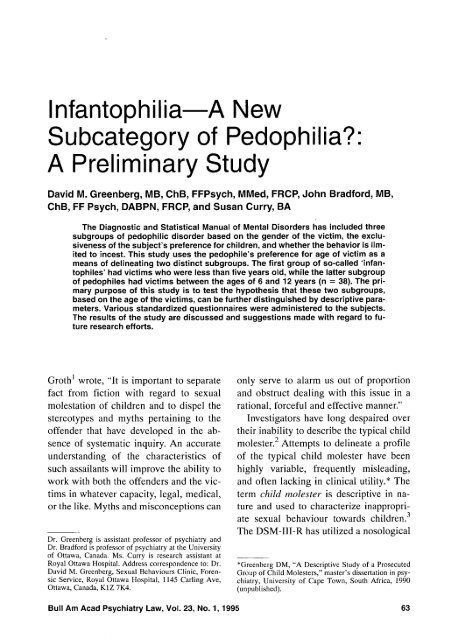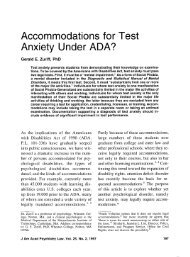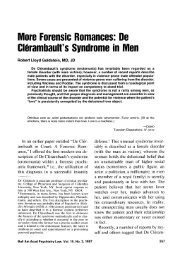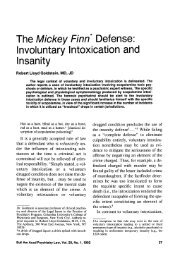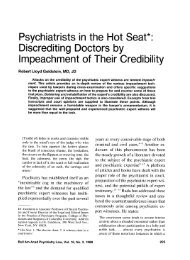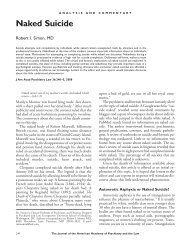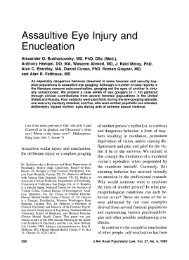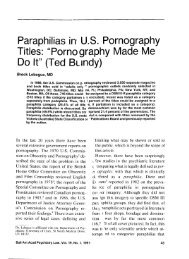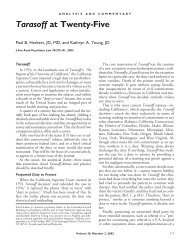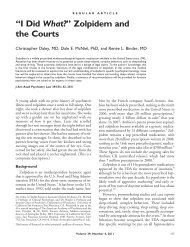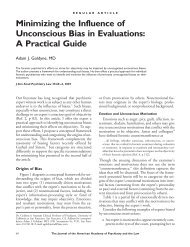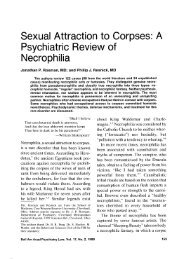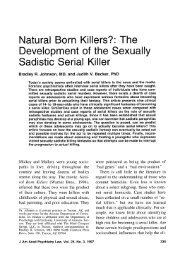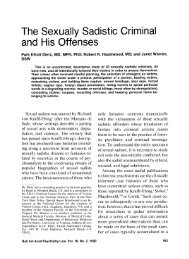Infantophilia-A New Subcategory of Pedophilia?: A Preliminary Study
Infantophilia-A New Subcategory of Pedophilia?: A Preliminary Study
Infantophilia-A New Subcategory of Pedophilia?: A Preliminary Study
Create successful ePaper yourself
Turn your PDF publications into a flip-book with our unique Google optimized e-Paper software.
<strong>Infantophilia</strong>-A <strong>New</strong><br />
<strong>Subcategory</strong> <strong>of</strong> <strong>Pedophilia</strong>?:<br />
A <strong>Preliminary</strong> <strong>Study</strong><br />
David M. Greenberg, MB, ChB, FFPsych, MMed, FRCP, John Bradford, MB,<br />
ChB, FF Psych, DABPN, FRCP, and Susan Curry, BA<br />
The Diagnostic and Statistical Manual <strong>of</strong> Mental Disorders has included three<br />
subgroups <strong>of</strong> pedophilic disorder based on the gender <strong>of</strong> the victim, the exclu-<br />
siveness <strong>of</strong> the subject's preference for children, and whether the behavior is lim-<br />
ited to incest. This study uses the pedophile's preference for age <strong>of</strong> victim as a<br />
means <strong>of</strong> delineating two distinct subgroups. The first group <strong>of</strong> so-called 'infan-<br />
tophiles' had victims who were less than five years old, while the latter subgroup<br />
<strong>of</strong> pedophiles had victims between the ages <strong>of</strong> 6 and 12 years (n = 38). The pri-<br />
mary purpose <strong>of</strong> this study is to test the hypothesis that these two subgroups,<br />
based on the age <strong>of</strong> the victims, can be further distinguished by descriptive para-<br />
meters. Various standardized questionnaires were administered to the subjects.<br />
The results <strong>of</strong> the study are discussed and suggestions made with regard to fu-<br />
ture research efforts.<br />
~roth' wrote, "It is important to separate<br />
fact from fiction with regard to sexual<br />
molestation <strong>of</strong> children and to dispel the<br />
stereotypes and myths pertaining to the<br />
<strong>of</strong>fender that have developed in the absence<br />
<strong>of</strong> systematic inquiry. An accurate<br />
understanding <strong>of</strong> the characteristics <strong>of</strong><br />
such assailants will improve the ability to<br />
work with both the <strong>of</strong>fenders and the victims<br />
in whatever capacity, legal, medical,<br />
or the like. Myths and misconceptions can<br />
Dr. Greenberg is assistant pr<strong>of</strong>essor <strong>of</strong> psychiatry and<br />
Dr. Bradford is pr<strong>of</strong>essor <strong>of</strong> psychiatry at the University<br />
<strong>of</strong> Ottawa, Canada. Ms. Curry is research assistant at<br />
Royal Ottawa Hospital. Address correspondence to: Dr.<br />
David M. Greenberg, Sexual Bchaviours Clinic, Foren-<br />
sic Service, Royal Ottawa Hospital, 1145 Carling Ave,<br />
Ottawa, Canada, K1Z 7K4.<br />
only serve to alarm us out <strong>of</strong> proportion<br />
and obstruct dealing with this issue in a<br />
rational, forceful and effective manner."<br />
Investigators have long despaired over<br />
their inability to describe the typical child<br />
mole~ter.~ Attempts to delineate a pr<strong>of</strong>ile<br />
<strong>of</strong> the typical child molester have been<br />
highly variable, frequently misleading,<br />
and <strong>of</strong>ten lacking in clinical utility.* The<br />
term child nzolester is descriptive in nature<br />
and used to characterize inappropriate<br />
sexual behaviour towards ~hildren.~<br />
The DSM-111-R has utilized a nosological<br />
*Greenberg DM, "A Descriptive <strong>Study</strong> <strong>of</strong> a Prosecuted<br />
Group <strong>of</strong> Child Molesters," master's dissertation in psy-<br />
chiatry, University <strong>of</strong> Cape Town, South Africa, 1990<br />
(unpublished).<br />
Bull Am Acad Psychiatry Law, Vol. 23, No. 1, 1995 63
classification where there is an assumption<br />
that sexual behaviour is predetermined<br />
by physiological and psychological<br />
sexual arousal with specific stimuli in<br />
a particular group <strong>of</strong> individuals. Although<br />
not all child molesters are pedophiles,<br />
this classification system for pedophilia<br />
has served to sharpen clinical<br />
boundaries for diagnostic, management,<br />
and research purposes. <strong>Pedophilia</strong> is by<br />
definition characterized by recurrent, intense<br />
sexual urges and sexually arousing<br />
fantasies <strong>of</strong> sexual activity involving<br />
prepubescent ~hildren.~ The DSM-111-R<br />
has also incorporated criteria for various<br />
subcategories <strong>of</strong> pedophilia. These subgroups<br />
<strong>of</strong> pedophilia are based on gender<br />
<strong>of</strong> the victim, exclusivity <strong>of</strong> the preference,<br />
and whether behavior is limited<br />
to incest. They are now commonly incorporated<br />
into clinical practice, although<br />
they lack scientific evidence for content<br />
validity.5' The author will briefly elaborate<br />
on these three subcategories <strong>of</strong><br />
pedophilia.<br />
Based on gender <strong>of</strong> their victims,<br />
Krafft-Ebing in his famous textbook, Psychopathia<br />
Sexualis, first distinguished<br />
between heterosexual, homosexual, and<br />
bisexual pedophiles.7 Comparing homosexual<br />
to heterosexual pedophiles, some<br />
authors have reported that homosexual<br />
child molesters are more likely to recidivate<br />
into pedophilic beha~iour;~, more<br />
likely to be classified sociopathic;10 less<br />
likely to be married;" and less likely to<br />
be drinking at the time <strong>of</strong> the <strong>of</strong>fense<br />
when compared with their heterosexual<br />
counterparts.12 These reported clinical<br />
differences may however depend more on<br />
the sample selection and the context or<br />
Greenberg, Bradford, and Curry<br />
situation <strong>of</strong> the disclosure than significant<br />
differences. A subcategory <strong>of</strong> pedophilia<br />
based on gender <strong>of</strong> the victims has nevertheless<br />
been incorporated into DSM classification<br />
system.<br />
Some authors have suggested a subcategory<br />
<strong>of</strong> pedophilia based on the preferred<br />
or primary sex object <strong>of</strong> the pedophile.<br />
~roth'~ coined the term fixated<br />
to refer to a child molester whose primary<br />
sexual attraction throughout his life is directed<br />
towards prepubertal children. He<br />
distinguished this subgroup from the regressed<br />
group whose primary sexual attraction<br />
was toward adult partners and<br />
who, under periods <strong>of</strong> stress, return to a<br />
previous stage <strong>of</strong> sexual gratification involving<br />
children. However, there has been<br />
no scientific validation <strong>of</strong> a connection<br />
between sexual contact with prepubertal<br />
children and a failure <strong>of</strong> normal developmental<br />
processes.14 Other authors have<br />
distinguished preference child molesters<br />
from adults who use children as surrogates<br />
for sexual gratification instead <strong>of</strong> a<br />
preferred but unavailable adult. 15, 16 precipitating<br />
factors suggested include marital<br />
and family stresses, alcohol and<br />
substance abuse, and other situational<br />
stressors. Use <strong>of</strong> the terms "preferred" or<br />
"fixated" has varied from author to author<br />
in the literature. The DSM-111-R has defined<br />
a group <strong>of</strong> pedophiles as an exclusive<br />
type who are attracted only to children,<br />
whereas a nonexclusive type are<br />
described as those who have a bisexual<br />
and variable orientation toward adults and<br />
children.<br />
The third and final subcategory <strong>of</strong> pedophile<br />
disorder in the DSM distinguishes<br />
between sexual arousal limited to<br />
64 Bull Am Acad Psychiatry Law, Vol. 23, No. 1, 1995
lnfantophilia<br />
incest versus extrafamilial victims. The<br />
dichotomy <strong>of</strong> incest versus nonincest <strong>of</strong>-<br />
fenders has also been challenged. Abel et<br />
aLt reported that in a sample <strong>of</strong> 140 inces-<br />
tuous fathers referred to the <strong>New</strong> York<br />
Clinic, 44 percent admitted to abusing fe-<br />
male children and 11 percent similarly<br />
abused male children outside the home.<br />
Langevin et a1. I' reported that there were<br />
no significant differences in the MMPI<br />
pr<strong>of</strong>iles, family history variables, or most<br />
questions on a sexual history question-<br />
naire between incestuous and nonincestu-<br />
ous child molesters. Quinsey et al.I8 re-<br />
ported that in their sample there were no<br />
significant differences in the physiologi-<br />
cal sexual arousal tests between incestu-<br />
ous and nonincestuous child molesters.<br />
Nevertheless, some authors have reported<br />
differences between biological and step-<br />
fathers. ~helan" compared biological fa-<br />
thers versus stepfathers who sexually<br />
abused their daughters and reported that<br />
the former tended to abuse multiple<br />
daughters, were more likely to abuse pu-<br />
bertal or postpubertal children, and to en-<br />
gage fully in intercourse with the child<br />
than the stepfathers. p us sell^' reported in<br />
her study <strong>of</strong> a nonclinical population that<br />
the incidents <strong>of</strong> incestuous sexual abuse<br />
was seven times higher in stepfathers as<br />
compared to biological fathers. The im-<br />
portance <strong>of</strong> this distinction has been sug-<br />
gested to be <strong>of</strong> clinical relevance by some<br />
authors, because incestuous <strong>of</strong>fenders are<br />
believed to respond better to treatment<br />
'Abel GG et a/., "Motivating Sexual Offenders for<br />
Treatment with Feedback <strong>of</strong> their Psychophysiological<br />
Assessment," presented at the World Congress <strong>of</strong> Be-<br />
havior Therapy, Washington, DC, 1993.<br />
than sex <strong>of</strong>fenders who molest children<br />
outside the family.2<br />
Researchers have suggested or rebutted<br />
other psychiatric subcategories <strong>of</strong> pedophilia<br />
based on various delineating variables.<br />
In his review <strong>of</strong> studies using the<br />
Minnesota Multiphasic Personality Inventory,<br />
~uinse~*' reported that there was little<br />
evidence to suggest the discriminative<br />
ability <strong>of</strong> the MMPI pr<strong>of</strong>iles <strong>of</strong> child molesters<br />
as compared to other sexual <strong>of</strong>fenders.<br />
conte14 suggested six clinical dimensions<br />
to delineate child molesters, but<br />
hastened to qualify that there was little research<br />
to support the usefulness <strong>of</strong> this<br />
topology. He suggested denial, sexual<br />
arousal, sexual fantasies, cognitive distortions,<br />
social skill deficits, and other psychological<br />
and social problems as possible<br />
clinical dimension for future research.<br />
Abel et a1.22 reported significant differences<br />
in cognitions and beliefs about<br />
child molestation between child abusers<br />
and a non<strong>of</strong>fender group. However, it has<br />
not been established whether there is any<br />
significant difference in the cognitive distortions<br />
among the various subcategories<br />
<strong>of</strong> pedophiles.t Alcohol and drug abuse,<br />
depression, poor self-concept, impulsivity,<br />
anger, and relationship problems are a<br />
few <strong>of</strong> the other psychological and social<br />
factors that have been suggested as possible<br />
variables to be used to discriminate<br />
subgroups <strong>of</strong> pedophiles.14 However,<br />
there has been limited research in this<br />
area, and empirical clinical findings have<br />
failed to stimulate interest with such dimensions.<br />
A notable exception has been<br />
studies using phallometric measurements,<br />
which has shown encouraging results. Penile<br />
plethysmography has proved to be<br />
Bull Am Acad Psychiatry Law, Vol. 23, No. 1, 1995 65
more reliable than assessments completed<br />
through self-report methods. Experimental<br />
literature indicates that penile tumescence<br />
is the single most reliable indicator<br />
<strong>of</strong> the early state <strong>of</strong> sexual arousal and<br />
can distinguish pedophilia from other<br />
groups. 23-27<br />
Pedophiles are by definition sexually<br />
aroused by prepubertal ~hildren.~ Few<br />
studies have been conducted using the age<br />
<strong>of</strong> the victim as a means <strong>of</strong> delineating<br />
subgroups <strong>of</strong> pedophilia disorder. Sexual<br />
abuse <strong>of</strong> infants and toddlers is not uncommon,<br />
although rarely does it lead to<br />
the successful conviction <strong>of</strong> a perpetrator.28<br />
Children as young as two or three<br />
months have been reported as victims <strong>of</strong><br />
sexual abuse.291 30 ~chetk~~~ reported that<br />
perpetrators <strong>of</strong> sexual abuse <strong>of</strong> infants and<br />
toddlers are usually opportunistic in their<br />
modus operandi and are more likely to be<br />
family members, babysitters, or daycare<br />
workers than strangers. This study uses<br />
the pedophile's preference for the age <strong>of</strong><br />
the victim as a means <strong>of</strong> delineating two<br />
distinct subgroups. Although age <strong>of</strong> victim<br />
has been adopted for purposes <strong>of</strong><br />
delineation, strictly speaking; the developmental<br />
(physical, sexual and psychological)<br />
stage <strong>of</strong> the child is the erotic<br />
component <strong>of</strong> sexual arousal. For purposes<br />
<strong>of</strong> this study, subjects who reported<br />
a sexual orientation for children less than<br />
five years old and who had <strong>of</strong>fended<br />
against a child <strong>of</strong> this age group were included<br />
in the sample <strong>of</strong> infantophiles,<br />
whereas those who were attracted to children<br />
between 6 and 12 years were classed<br />
as pedophiles. The primary purpose <strong>of</strong><br />
this study is to test the hypothesis that<br />
these two subgroups, based on age <strong>of</strong> vic-<br />
Greenberg, Bradford, and Curry<br />
tims, can be distinguished by further de-<br />
scriptive parameters.<br />
Method<br />
The subjects for the study were as-<br />
sessed at the Sexual Behaviours Clinic <strong>of</strong><br />
a psychiatric teaching hospital. The sub-<br />
jects were referred to the clinic primarily<br />
by lawyers or the courts. Others were re-<br />
ferred by their physicians or were self-<br />
referrals. Almost all the subjects were<br />
pretrial at the time <strong>of</strong> this study. The pa-<br />
tients included were those who admitted<br />
to sexually assaulting children 12 years<br />
old or younger and who reported recur-<br />
rent intense sexual urges and sexually<br />
arousing fantasies with these children.<br />
Only patients who were at least 16 years<br />
old, and at least five years older than their<br />
victims, were included in the study. Sub-<br />
jects were grouped according to the age<br />
<strong>of</strong> the victims. The selected pedophile<br />
group reported <strong>of</strong>fending against children<br />
between the ages <strong>of</strong> 8 and 12 years old,<br />
whereas the infantophile group reported<br />
<strong>of</strong>fending against children less than five<br />
years <strong>of</strong> age. Those subjects who reported<br />
molesting children from both groups or<br />
who molested children between five and<br />
eight years old, were excluded from the<br />
study to reduce error variance in the data.<br />
Pedophiles limited to incest were ex-<br />
cluded from the sample. The final sample<br />
consisted <strong>of</strong> 10 male infantophiles and 28<br />
pedophiles.<br />
Procedure<br />
Participation was voluntary and contin-<br />
gent upon written informed consent. In-<br />
formation about age, marital status, em-<br />
ployment, and education was collected.<br />
66 Bull Am Acad Psychiatry Law, Vol. 23, No. 1, 1995
lnfantophilia<br />
Data on the age and number <strong>of</strong> their vic-<br />
tims, amount and nature <strong>of</strong> sexual con-<br />
tact, their relationship to the victim, past<br />
history <strong>of</strong> violence, and previous criminal<br />
convictions was obtained. Subjects were<br />
administered several questionnaires in-<br />
cluding the Derogatis Sexual Functioning<br />
Inventory (DSFI), which is a multidimen-<br />
sional test to measure the current level <strong>of</strong><br />
sexual functioning <strong>of</strong> an indi~idual.~'<br />
They completed the Abel and Becker<br />
Pedophilic Cognition Distortion Scale,<br />
which measures cognitions or beliefs<br />
about molesting children or the conse-<br />
quences <strong>of</strong> such behavior;22 the Buss-<br />
~urkee~~ Hostility Inventory, which measures<br />
different kinds <strong>of</strong> hostility and<br />
intensities <strong>of</strong> the modes <strong>of</strong> expression;<br />
the Michigan Alcohol Screening Test<br />
(MAST), which is a structured interview<br />
instrument to detect history <strong>of</strong> alcoholism;33><br />
34 and a Sexual History Inventory,*<br />
which assesses past sexual activity.<br />
For this study the data collected from<br />
these questionnaires and scales were analyzed<br />
to determine if there were any differences<br />
between the two groups and if<br />
these groups could be differentiated based<br />
on their questionnaire and scale responses.<br />
Results<br />
The median age for the infantophile<br />
group was 23.5 years old and for the pe-<br />
dophile group, 32 years old. There was a<br />
difference in the mean rank <strong>of</strong> ages be-<br />
tween the two groups (Mann-Whitney<br />
U = 78, p < .05). The marital status for<br />
the two groups did not differ. Overall,<br />
*~radford JM et nl., "Sexual History Inventory," University<br />
<strong>of</strong> Ottawa, Canada, 1992 (unpublished).<br />
63.2 percent <strong>of</strong> the sample were single,<br />
21.1 percent were either married or in<br />
common-law marriages, and 15.8 percent<br />
were divorced. Approximately half <strong>of</strong> the<br />
total sample was employed at the time <strong>of</strong><br />
assessment.<br />
The mean score for the youngest vic-<br />
tims' age was 3.9 years (SD = 0.88) for<br />
the infantophile group and 9.29 years<br />
(SD = 2.06) for the pedophile group. By<br />
design there was a significant difference<br />
between these ages (t = - 11.49; df =<br />
34.64; p < .001). Of the entire sample,<br />
28.9 percent had sexual contact with only<br />
male children, 65.8 percent with only fe-<br />
male children, and 5.3 percent had sexual<br />
contact with both male and female chil-<br />
dren. There were no differences between<br />
the groups on gender preference (X2 =<br />
0.99; p > .05). The number <strong>of</strong> victims re-<br />
ported per <strong>of</strong>fender for the entire sample<br />
ranged from one to five. Sixty-five point<br />
eight percent <strong>of</strong> the sample had admitted<br />
to only one victim.<br />
Forty-seven point four percent <strong>of</strong> the<br />
sample used no physical violence or<br />
threats <strong>of</strong> violence against their victims.<br />
Thirty-nine point four percent used<br />
threats either with or without a weapon<br />
present, 10.5 percent caused minor in-<br />
juries to their victims either with or with-<br />
out weapons, and 2.6 percent mutilated or<br />
murdered their victims. There were no<br />
differences between the groups. Twenty-<br />
one point one percent <strong>of</strong> the sample were<br />
strangers to their victims4ne subject<br />
from the infantophile group and seven<br />
from the pedophile group. Sixty-three<br />
point two percent <strong>of</strong> the sample were ac-<br />
quaintances or friends who invariably<br />
were babysitting the victims, 5.3 percent<br />
Bull Am Acad Psychiatry Law, Vol. 23, No. 1, 1995 67
were relatives (uncles, grandfathers,<br />
cousins, brothers, etc.) and 10.5 percent<br />
were stepfathers <strong>of</strong> their victims. There<br />
were no statistical differences between<br />
the two groups.<br />
Twenty-nine point four percent <strong>of</strong> the<br />
total sample reported having had sexual<br />
contact with someone who was 16 years<br />
<strong>of</strong> age or older when they were less than<br />
12 years old. For the two infantophile<br />
subjects who reported being sexually vic-<br />
timized in their own childhood, the con-<br />
tact occurred when they were six years<br />
old. The mean age <strong>of</strong> occurrence <strong>of</strong> abuse<br />
on the eight pedophile subjects who re-<br />
ported sexual abuse in their own child-<br />
hood was 7.5 years (SD = 2).<br />
Rates <strong>of</strong> alcohol dependency and drug<br />
abuse did not differ between the groups.<br />
Twenty-eight point nine percent <strong>of</strong> the en-<br />
tire sample had a history <strong>of</strong> alcohol de-<br />
pendency and 18.4 percent had a history<br />
<strong>of</strong> drug abuse. Twenty-eight point six per-<br />
cent <strong>of</strong> the entire sample had scores on the<br />
MAST that were suggestive or indicative<br />
<strong>of</strong> alcoholism. The groups did not differ<br />
on their MAST scores.<br />
Overall, 10.5 percent had a history <strong>of</strong><br />
violence and 89.5 percent had no such<br />
history. Seventy-two point two percent <strong>of</strong><br />
the total sample had no previous convic-<br />
tions, and 27.8 percent had one or more<br />
past conviction. There were no differ-<br />
ences between the groups on history <strong>of</strong><br />
violence or on the number <strong>of</strong> previous<br />
convictions. The two groups did not differ<br />
on the overall Buss-Durkee Hostility In-<br />
ventory score nor on any <strong>of</strong> the subscales.<br />
Twenty-six point five percent <strong>of</strong> the total<br />
sample had scores above the cut-<strong>of</strong>f point<br />
<strong>of</strong> 38. On the subscales, 20.6 percent <strong>of</strong><br />
Greenberg, Bradford, and Curry<br />
the sample had a high score on Nega-<br />
tivism, 41.2 percent on Resentment, 61.8<br />
percent on Suspicion, 23.5 percent on As-<br />
sault, 23.5 percent on Indirect Hostility,<br />
5.9 percent on Irritability, 17.6 percent on<br />
Verbal Hostility, and 60.6 percent on<br />
Guilt.<br />
On the sexual functioning index (SFI)<br />
<strong>of</strong> the DSFI, the groups did not differ on<br />
overall sexual functioning. Low t scores<br />
on the DSFI indicate poorer functioning.<br />
Ninety-seven percent <strong>of</strong> the sample<br />
scored below the cut-<strong>of</strong>f point <strong>of</strong> the SFI,<br />
indicating a poor overall level <strong>of</strong> sexual<br />
functioning. Although a large proportion<br />
<strong>of</strong> the sample scored low on all <strong>of</strong> the sub-<br />
scales and the summary index (the SFI),<br />
50 percent <strong>of</strong> the sample reported that<br />
their subjective judgement <strong>of</strong> their sexual<br />
satisfaction was adequate or above aver-<br />
age. Gender identity was the only sub-<br />
scale that was significantly different be-<br />
tween the groups. More <strong>of</strong> the pedophile<br />
group (92.6%) scored below the cut-<strong>of</strong>f<br />
score than did the infantophile group<br />
(55.6%), suggesting that the infantophiles<br />
perceive themselves as having more typi-<br />
cally masculine characteristics than the<br />
pedophiles (Fisher's Exact Test = 4.27;<br />
p < .05). The groups did not differ on any<br />
<strong>of</strong> the remaining subscales. Large propor-<br />
tions <strong>of</strong> both groups scored below the cut-<br />
<strong>of</strong>f score. On the various subscales: 83.3<br />
percent scored below a t score <strong>of</strong> 50 on<br />
the information subscale, indicating a<br />
poor level <strong>of</strong> sexual information; 91.7<br />
percent scored low on sexual experience<br />
(diversity <strong>of</strong> sexual activities); and 72.2<br />
percent scored below the norm on the<br />
Drive subscale that measure total sexual<br />
activity. Ninety-one point seven percent<br />
68 Bull Am Acad Psychiatry Law, Vol. 23, No. 1, 1995
lnfantophilia<br />
<strong>of</strong> the sample scored low on the sexual at-<br />
titudes subscale, indicating that the ma-<br />
jority <strong>of</strong> the sample held conservative<br />
beliefs about sexual activity. Sixty-three<br />
point nine percent <strong>of</strong> the sample scored<br />
low on the psychological symptoms<br />
subscale, and 80.6 percent scored low<br />
on the affect subscale, indicating that<br />
they show a greater range <strong>of</strong> negative<br />
and dysphoric emotions than positive<br />
emotions. Seventy-seven point eight per-<br />
cent <strong>of</strong> the sample had t scores less<br />
than 50 on the fantasy subscale, which<br />
measures the diversity <strong>of</strong> sexual fantasies,<br />
and 94.3 percent had low body image<br />
scores, indicating a poor perception <strong>of</strong><br />
their bodies. Fifty-one point four percent<br />
had a low satisfaction score, which re-<br />
flects the extent <strong>of</strong> the respondent's sat-<br />
isfaction with his sex life. The groups<br />
did not differ on the cognitive distor-<br />
tions scale (infantophiles, mean = 4.18,<br />
SD = .49; pedophiles, mean = 4.38,<br />
SD = .60).<br />
Discussion<br />
The DSM has included three subcategories<br />
<strong>of</strong> pedophilic disorder in the taxonomic<br />
system.4 Clinically these subcategories<br />
have limited discriminating value<br />
in practice with treatment and management<br />
interventions, with the possible exception<br />
<strong>of</strong> gender <strong>of</strong> victim (i.e., homosexual<br />
pedophiles). These subcategories<br />
lack predictive value with variables such<br />
as dangerousness and recidivism. Harry et<br />
0 1 . ~ used ~ age <strong>of</strong> the victim to delineate<br />
subgroups <strong>of</strong> sexual <strong>of</strong>fenders that included<br />
child molesters, rapists, and an intermediate<br />
group. They found motivational<br />
and rnodcls operandi differences<br />
between the groups based on the age <strong>of</strong><br />
the victims. Knight et reported that<br />
the victim's age is <strong>of</strong> particular importance<br />
in understanding sex crimes. This<br />
study evaluated two distinct subgroups <strong>of</strong><br />
pedophilic disorder based on the age <strong>of</strong><br />
the victims. Strict DSM-111-R inclusion<br />
criteria were adopted and subjects were<br />
excluded from the sample when there was<br />
overlap between the two groups. Although<br />
the number <strong>of</strong> subjects was only<br />
38, analysis showed no essential differences<br />
between these two subgroups.<br />
There were no differences between these<br />
two groups when comparing their gender<br />
<strong>of</strong> victim, number <strong>of</strong> victims, use <strong>of</strong> alcohol<br />
or drugs, and history <strong>of</strong> violence or<br />
hostility. Both groups clearly had a dysfunctional<br />
sexual functioning index; the<br />
only significant variable between these<br />
two subgroups was the masculinity scale.<br />
The significance <strong>of</strong> this finding is unclear<br />
at this stage. ~alichman~~ reported that<br />
child molesters who abuse prepubescent<br />
children demonstrate significantly more<br />
psychopathology, emotional disturbance<br />
and low self-esteem than adult <strong>of</strong>fenders.<br />
Our findings do not support a linear relationship<br />
between victim age and state/<br />
trait anger in sex <strong>of</strong>fenders as reported by<br />
Kalichman. Our study has not evaluated<br />
the potential for this taxonomy with regard<br />
to recidivism or prognosis with treatment<br />
interventions. The usefulness <strong>of</strong> this<br />
taxonomic dimension may therefore warrant<br />
further investigation.<br />
~chetk~~~ reported that perpetrators <strong>of</strong><br />
sexual abuse <strong>of</strong> infants or toddlers were<br />
opportunistic family members, babysitters,<br />
or owners or employees <strong>of</strong> day care<br />
facilities. Our study concurred that almost<br />
Bull Am Acad Psychiatry Law, Vol. 23, No. 1, 1995 69
two thirds <strong>of</strong> the infantophile group were<br />
acquaintances or friends <strong>of</strong> the parents<br />
who were invariably babysitting the children;<br />
however, there were no differences<br />
between the two groups. The results tend<br />
to support that groupings based on victim<br />
age show no modus operandi differences<br />
in gaining access to victims.<br />
Almost one-third <strong>of</strong> pedophiles report<br />
being sexually victimized during their<br />
own ~hildhood.~~'~' Greenberg et al.39 delineated<br />
two subgroups <strong>of</strong> child molesters<br />
based on the selection <strong>of</strong> the age <strong>of</strong> the<br />
victims. Pedophiles reported being sexually<br />
abused during the prepubertal period,<br />
whereas hebephiles, who are by definition<br />
attracted to pubertal children, reported<br />
being sexually molested during puberty.<br />
Our study found that infantophiles reported<br />
being sexually victimized at a<br />
younger age than the pedophile group, although<br />
this finding may be attributable to<br />
chance. Future research is needed to evaluate<br />
the content validity <strong>of</strong> the dimension<br />
<strong>of</strong> age <strong>of</strong> victim as a means <strong>of</strong> subcategorizing<br />
subgroups and pedophilia. Likewise,<br />
other subcategories already incorporated<br />
in the DSM need further research<br />
validation.<br />
References<br />
Groth AN: Men Who Rape: The Psychology<br />
<strong>of</strong> the Offender. <strong>New</strong> York: Plenum Press,<br />
1979<br />
Grubin DH, Kennedy HG: Sexual deviancy.<br />
Curr Opin Psychiatry. 2:745-9, 1989<br />
Langevin R, Hucker SJ, Handy L: Erotic pref-<br />
erence and aggression in pedophilia: a com-<br />
parison <strong>of</strong> heterosexual, homosexual and bi-<br />
sexual types, in Erotic Preference, Gender<br />
Identity and Aggression in Men: <strong>New</strong> Re-<br />
Greenberg, Bradford, and Curry<br />
search Studies. Edited by Langevin R. Hills-<br />
dale, NJ: Erlbaum Associates, 1985<br />
American Psychiatric Association: Diagnostic<br />
and Statistical Manual <strong>of</strong> Mental Disorders<br />
(ed 3, rev). Washington, DC: APA, 1987<br />
Barnard GW, Fuller AK, Robbins L, Shaw T:<br />
The Child Molester: An Integrated Approach<br />
to Evaluation and Treatment. <strong>New</strong> York: Brun-<br />
ner/Mazel, 1989<br />
Knight RA, Prentky RA: Classifying sexual<br />
<strong>of</strong>fenders: the development and corroboration<br />
<strong>of</strong> taxonomic models, in Handbook <strong>of</strong> Sexual<br />
Assault. Edited by Marshall WL, Laws DR,<br />
Barbaree ME. <strong>New</strong> York: Plenum Press, 1990,<br />
pp 23-52<br />
Hartwich A: Aberrations <strong>of</strong> Sexual Life. after<br />
the Psychopathia Sexualis <strong>of</strong> Dr. RV Krafft-<br />
Ebing (translated by Burbury AV). London:<br />
Staples Press, 1959<br />
Sturgeon VH, Taylor J: Report <strong>of</strong> a five-year<br />
follow-up study <strong>of</strong> mentally disordered sex <strong>of</strong>-<br />
fenders released from Atascachero State Hos-<br />
pital in 1973. Crim Justice J 451-63. 1980<br />
Frisbie LV, Dondis EH: Recidivism among<br />
treated sex <strong>of</strong>fenders. Sacremento: California<br />
Dept. <strong>of</strong> Mental Health, 1965<br />
Fitch JH: Men convicted <strong>of</strong> sexual <strong>of</strong>fences<br />
against children. Br J Criminology 3:18-37,<br />
1962<br />
Mohr JW, Turner RW, Jerry MB: <strong>Pedophilia</strong><br />
and Exhibitionism. Toronto, Canada: Univer-<br />
sity <strong>of</strong> Toronto Press, 1964<br />
Rada RT: Alcoholism and the child molester.<br />
Ann N Y Acad Sci 237:4924,1976<br />
Groth AN, Hobson WF, Gary TS: The child<br />
molester: clinical observations, in Social Work<br />
and Child Sexual Abuse. Edited by Conte J,<br />
Shore DA. <strong>New</strong> York: Hawthorn, 1982. pp<br />
129-44<br />
Conte JR: Clinical dimensions <strong>of</strong> adult sexual<br />
abuse <strong>of</strong> children. Behav Sci Law 3:341-<br />
54, 1985<br />
Karpman B: The Sexual Offender and His Of-<br />
fenses. <strong>New</strong> York: Julian Press, 1964<br />
Howells K: Adult sexual interest in children:<br />
considerations relevant to the theories and<br />
aetiology, in Adult Sexual Interest in Children.<br />
Edited by Cook M, Howells K. London: Acad-<br />
emic Press, 1981, pp 55-294<br />
Langevin R, Handy L, Russan AE, Day D: Are<br />
incestuous fathers pedophilic, aggressive or<br />
alcoholic?, in Erotic Preference, Gender Iden-<br />
tity and Aggression in Men: <strong>New</strong> Research<br />
Studies. Edited by Langevin R. Hillsdale, NJ:<br />
Erlbaum Associates, 1985<br />
Quinsey VL. Chaplin TC, Carrigan WF: Sex-<br />
ual preferences among incestuous and non-<br />
Bull Am Acad Psychiatry Law, Vol. 23, No. 1, 1995
lnfantophilia<br />
incestuous child molesters. Behav Therapy 10:<br />
526-65,1979<br />
19. Phelan P: The process <strong>of</strong> incest: biological fa-<br />
ther and step-father families. Child Abuse<br />
Negl 10531, 1986<br />
20. Russell DEH: The incidents and prevalence <strong>of</strong><br />
intrafamilial and extrafamilial sexual abuse <strong>of</strong><br />
female children. Child Abuse Negl 7:13346,<br />
1983<br />
21. Quinsey VL: The assessment and treatment <strong>of</strong><br />
child molesters. Can Psychol Rev 18:204-20,<br />
1977<br />
22. Abel GG, Gore DK, Holland CL, Kemps N,<br />
Becker JV. The measurement <strong>of</strong> the cognitive<br />
distortions <strong>of</strong> child molesters. Ann Sexual Res<br />
2: 135-53. 1989<br />
23. Barlow DA: Assessment <strong>of</strong> sexual behaviour<br />
in Handbook <strong>of</strong> Behavioural Assessment.<br />
Edited by Ciminero A, Calhoun HE, Adams<br />
HE. <strong>New</strong> York: Wiley, 1977<br />
24. Rosen RC, Keefe FJ: The measurement <strong>of</strong><br />
human penile tumescence. Psychophysiology<br />
15:366-76, 1978<br />
25. Zukerman M: Physiological measures <strong>of</strong> sex-<br />
ual arousal in the human. Psychol Bull 25:<br />
297-372,1971<br />
26. Freund K: Erotic preference in pedophilia.<br />
Behav Res Ther 5:33948, 1967<br />
27. Quinsey VL: The assessment and treatment <strong>of</strong><br />
child molesters: a review. Can Psychol Rev<br />
18:204-20, 1977<br />
28. Schetky. DH: The sexual abuse <strong>of</strong> infants and<br />
toddlers, in Review <strong>of</strong> Psychiatry (vol 10).<br />
Edited by Tasman A. Goldfinger SM. Wash-<br />
ington. DC: APA 308-18, 1991<br />
29. Cupoli JM, Sewell PM: One thousand<br />
fifty-nine children with a chief compliant <strong>of</strong><br />
Bull Am Acad Psychiatry Law, Vol. 23, No. 1, 1995<br />
sexual abuse. Child Abuse Negl 12:151-62.<br />
1988<br />
30. Dube R, Hebert M: Sexual abuse <strong>of</strong> children<br />
under 12 years <strong>of</strong> age: a review <strong>of</strong> 511 cases.<br />
Child Abuse Negl 12:321-30, 1988<br />
31. Derogatis LR: Psychological assessment <strong>of</strong><br />
psychosexual functioning. Psychiatr Clin<br />
North Am 3:113-31, 1980<br />
32. Buss AH, Durkee AA: An inventory for as-<br />
sessing different kinds <strong>of</strong> hostility. J Consult<br />
Clin Psychol 21(4):343-9, 1957<br />
33. Gibbs AL: Validity and reliability <strong>of</strong> the<br />
Michigan Alcohol Screening Test: a review.<br />
Drug Alcohol Depend 12:279-85,1983<br />
34. Selzer M, Vinokur A, Rooijan L: A self-ad-<br />
ministered Short Michigan Alcohol Screening<br />
Test (S.M.A.S.T.). J Stud Alcohol 36:117-26.<br />
1975<br />
35. Harry B. Pierson TR, Kuznetsov A: Correlates<br />
<strong>of</strong> sex <strong>of</strong>fender and the <strong>of</strong>fense traits by victim<br />
age. J Forensic Sci 38:1068-74, 1993<br />
36. Knight RA. Rosenberg R, Schneider BA:<br />
Classification <strong>of</strong> sexual <strong>of</strong>fenders: Perspec-<br />
tives, methods and validation. in Rape and<br />
Sexual Assault. Edited by Burgess AW. <strong>New</strong><br />
York: Garland, 1985, pp 222-93<br />
37. Kalichman SC: Psychopathology and person-<br />
ality characteristics <strong>of</strong> criminal sex <strong>of</strong>fenders<br />
as a function <strong>of</strong> victim age. Arch Sex Behav<br />
20:187-97,1991<br />
38. Hanson RK, Slater S: Sexual victimization in<br />
the history <strong>of</strong> sex abusers: a review. Ann Sex<br />
Res 1:485-99, 1988<br />
39. Greenberg DM, Bradford JM, Curry S: A<br />
comparison <strong>of</strong> sexual victimization in the<br />
childhoods <strong>of</strong> pedophiles and hebephiles. J<br />
Forensic Sci 38:432-6, 1993


